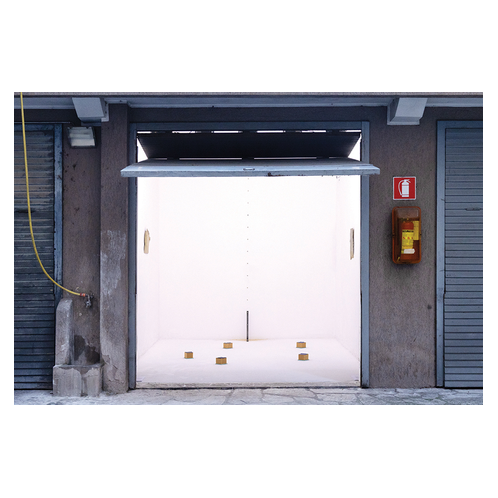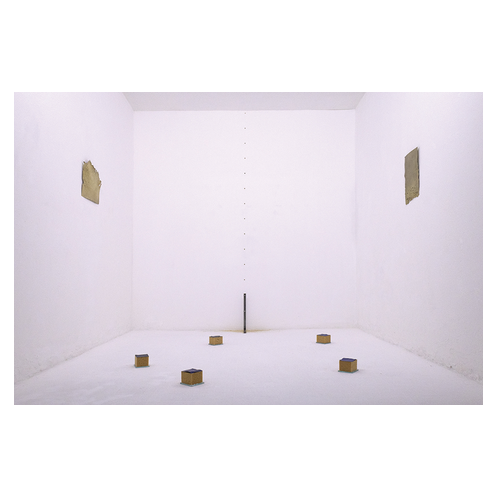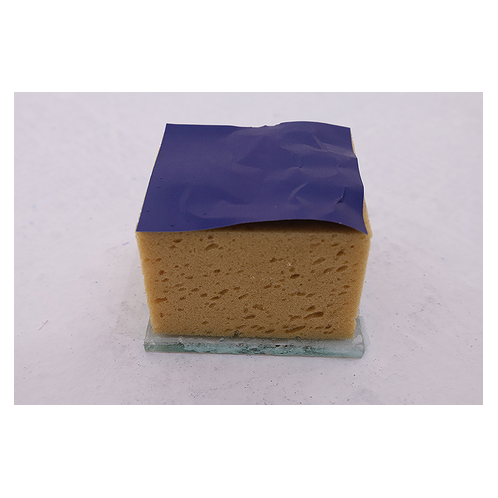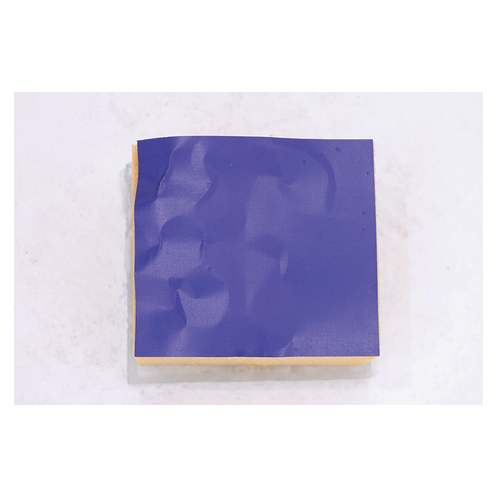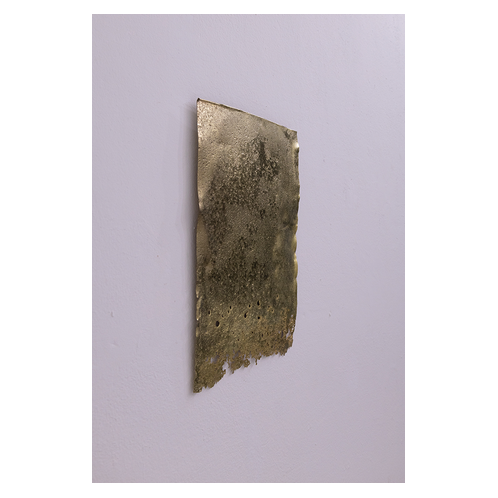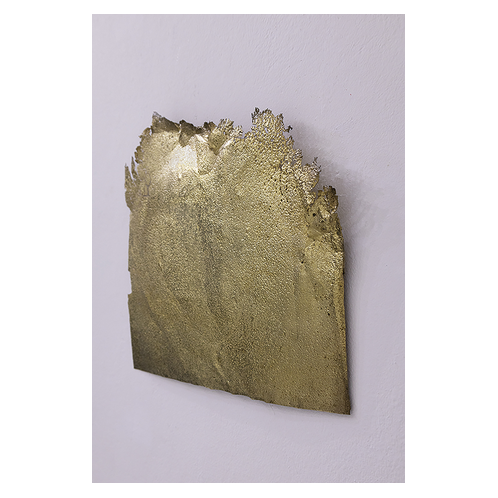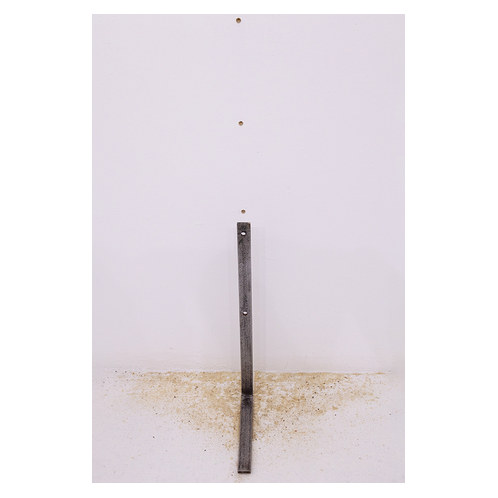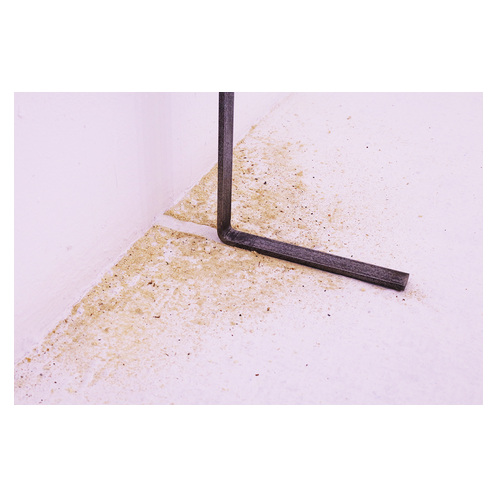Brambilla-Fais-Lucchini
SIMONE BRAMBILLA
ANDREA FAIS
RITA LUCCHINI
ALL’ULTIMO MOMENTO
(DEL TEMPO UTILE)
un dialogo tra Gianni Caravaggio e Gaspare Luigi Marcone
dal 24 febbraio al 30 marzo 2025
solo su appuntamento
GLM: All’ultimo momento (del tempo utile) ovvero in extremis. L’atmosfera della mostra sembra evocare movimenti plurimi: i fori del lavoro di Rita Lucchini (Casalmaggiore, 2000) si sviluppano potenzialmente all’infinito, tracciando traiettorie verticali e orizzontali; contemporaneamente l’installazione di Simone Brambilla (Monza, 2000) ruota su sé stessa coinvolgendo lo spazio artistico all’interno dello spazio universale, nel globo terracqueo; mentre i due lavori a parete di Andrea Fais (Milano, 2001) profumano di albe e tramonti, tra ascesa e discesa...
GC: Infatti, più che la sensazione di una presenza istantanea con cui gli oggetti sovente investono la nostra percezione, i lavori in mostra spingono l’immaginazione a inserirli all’interno di un flusso temporale – che forse è reversibile nel suo scorrere direzionale – oppure che fugge inesorabilmente nell’attimo seguente verso un futuro incerto e forse apocalittico.
GLM: Un futuro incerto e forse apocalittico… come potrebbe essere stato il passato… Le sculture metalliche di Fais, lastre ferite, abbandonate, recuperate dall’artista in luoghi desolati o industriali, sembrano rivivere grazie a un “battesimo artistico” che lava, pulisce, ricopre la materia grezza facendola rinascere con una nuova pelle e con una nuova vita.
GC: Infatti l’oggetto in sé non è il protagonista estetico, ma è, semmai, un testimone che qualcosa sia successo e che stia ancora succedendo, mentre stiamo contemplando un attimo del suo mostrarsi, come fosse un suo fermo immagine. È attimo visibile dell’intero fluire dell’evento invisibile. È l’intero fluire dell’evento che si estetizza per la percezione. Il “mare” di Simone Brambilla, per esempio, sta per traboccare dalle parcelle di spugne pregne di acqua sulla tenera superfice cartacea blu, ma allo stesso tempo esse si stanno anche prosciugando, offrendoci quasi uno scenario geoclimatico in ampia scala temporale. La struttura a “L” di Rita Lucchini sembra che sia appena scivolata giù lungo il muro disegnando il suo tragitto (è stata forse fissata male?); allo stesso tempo, sembra desiderare di tornare al suo posto. Si insidia una questione paradossale in chi guarda: ci si chiede se i dubbi ci fanno bene o se sia meglio essere governati da una precostituita certezza.
GLM: La questione paradossale citata, nel lavoro di Rita Lucchini, è già insita nel titolo del lavoro, contemporaneamente evocativo e affermativo: Ritorno dove non sono mai stato. E anche per Fais i titoli sono un momento dialettico, generativo del lavoro…
GC: Il lavoro di Andrea Fais sembra volerci dare una risposta: Brillare prima di sparire. Il godimento dell’istante, latentemente, ci minaccia con la sua inevitabile sparizione e degenerazione nel passare del tempo. Godiamoci allora l’evento di questo “fermo immagine” finché si può!
Didascalie:
Simone Brambilla, Oceani, 2024, spugne, stampa su carta, vetro, acqua, sale; dimensioni ambientali (ciascun elemento circa 12 × 11 × 8 cm)
Andrea Fais, Brillare prima di sparire 10, 2024, ferro, nichel, ottone, 40 × 20 cm; Brillare prima di sparire 11, 2024, ferro, nichel, ottone, 38 × 47 cm
Rita Lucchini, Ritorno dove non sono mai stato, 2023, ferro, fori, polvere di intonaco, 2 × 50 × 23 cm
Si ringrazia: Renata Fabbri www.renatafabbri.it
THE OPEN BOX
MILANO
A.P.S.
Via G.B. Pergolesi 6
MILANO
www.theopenbox.org
info.theopenbox.org@gmail.com
+393382632596
SIMONE BRAMBILLA
ANDREA FAIS
RITA LUCCHINI
ALL’ULTIMO MOMENTO
(DEL TEMPO UTILE)
a dialogue between Gianni Caravaggio and Gaspare Luigi Marcone
from 24 February to 30 March 2025
by appointment only
GLM: All’ultimo momento (del tempo utile) – At the last moment (of useful time) or in extremis. The atmosphere of the exhibition seems to evoke multiple movements: the perforations in the work of Rita Lucchini (Casalmaggiore, 2000) have a potentially infinite development, tracing vertical and horizontal trajectories; at the same time, the installation by Simone Brambilla (Monza, 2000) rotates about itself, engaging the artistic space within the universal space, within the terrestrial globe; while the two works on the wall by Andrea Fais (Milano, 2001) have the scent of dawns and dusks, ascent and descent…
GC: That’s right, rather than a sensation of an instantaneous presence, with which objects frequently invest our perception, the works on show encourage the imagination to enter a temporal flow – that is perhaps reversible in direction – or that inexorably escapes in the following moment towards an uncertain and perhaps apocalyptic future.
GLM: An uncertain and perhaps apocalyptic future… like the past may have been… The metal sculptures by Fais, lacerated, abandoned sheets recovered by the artist in desolate or industrial locations, seem to re-live thanks to an “artistic baptism” that washes, polishes and covers the raw material, allowing it to be reborn with a new skin and a new life.
GC: In fact, the object itself is not the aesthetic protagonist, but rather a witness to something that happened and which is still happening while we are contemplating a moment in its showing itself as a freeze frame of itself. It is a visible instant of the entire flow of the invisible event. It is the entire flow of the event that aestheticizes itself for perception. Simone Brambilla’s “sea”, for example, is about to spill out of the sponges soaked with water on the tender blue paper surface, but at the same time they are also drying out, offering us almost a geoclimatic scenario on a broad temporal scale. The L-shaped structure by Rita Lucchini seems to have just slipped down from the wall, tracing its route (had it perhaps been attached badly?); at the same time, it seems to want to return to its place. A paradoxical question insinuates itself into the observer: we wonder whether doubts are good for us or whether it would be better to be governed by a preconceived certainty.
GLM: In the work of Rita Lucchini, the paradoxical question you mention is already intrinsic to the title of the piece, both evocative and affirmative: Ritorno dove non sono mai stato (I return to where I’ve never been). For Fais too, the titles are a dialectic, generative moment for the work…
GC: The work of Andrea Fais seems to want to provide us with an answer: Brillare prima di sparire (Shine before disappearing). The latent enjoyment of the instant threatens us with its inevitable disappearance and degeneration with the passing of time. So let’s enjoy the event of this “freeze frame” while we can!
Captions:
Simone Brambilla, Oceani (Oceans), 2024, sponges, print on paper, glass, water, salt; environmental dimensions (each element about 12 × 11 × 8 cm)
Andrea Fais, Brillare prima di sparire 10 (Shine before disappearing 10), 2024, iron, nickel, brass, 40 × 20 cm; Brillare prima di sparire 11 (Shine before disappearing 11), 2024, iron, nickel, brass, 38 × 47 cm
Rita Lucchini, Ritorno dove non sono mai stato (I return to where I’ve never been), 2023, iron, holes, plaster dust, 2 × 50 × 23 cm
Thanks to: Renata Fabbri www.renatafabbri.it
THE OPEN BOX
MILANO
A.P.S.
Via G.B. Pergolesi 6
MILANO
www.theopenbox.org
info.theopenbox.org@gmail.com
+393382632596

